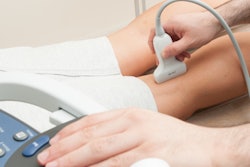
Ultrasound is an effective tool for assessing the future risk of deep vein thrombosis (DVT) in patients who receive radiofrequency ablation (RFA) or laser ablation (LA) for superficial venous conditions such as varicose veins, according to a study published online June 12 in the Annals of Vascular Surgery.
The researchers from Stanford University also found that ultrasound helped clarify which ablation technique is safer.
"The rates of DVT decreased over time, suggesting an improvement in overall procedural safety; however, LA demonstrated a considerable decreased risk for DVT when compared to RFA," first author Dr. Nathan Itoga and colleagues wrote.
Studies have shown that both radiofrequency ablation and laser ablation are at least as successful as surgery for treating conditions such as varicose veins, and they can be performed without general anesthesia and tend to have fewer negative effects. But the rates of complications such as DVT after venous ablation procedures have been unclear, the group noted.
"Despite the relative safety of these techniques, LA and RFA may cause endovenous heat-induced thrombosis which ... may extend or propagate, leading to deep vein thrombosis," the researchers wrote. "In rare cases, LA and RFA procedures may also lead to pulmonary embolism. The overall risk for thromboembolic complication after endovenous ablation is controversial, and estimates in the literature vary greatly, from less than 1% to 18%."
The study included data from Truven Health Analytics MarketScan databases from 2007 and 2016 for a cohort of patients who underwent RFA or LA and had a follow-up duplex ultrasound scan within seven days and 30 days of the ablation procedure. Of the patient cohort, 256,999 underwent 433,286 ablations, 44.4% of which were radiofrequency and 55.6% of which were laser.
Of these patients, 1.9% had a newly diagnosed DVT within seven days of the procedure, and 3.1% had a newly diagnosed DVT within 30 days of the procedure. Factors associated with a decreased risk of DVT within 30 days included having had laser ablation, being female, and having sclerotherapy performed on the same day as the ablation; factors associated with an increased risk of DVT included a diagnosis of peripheral artery disease and undergoing stab phlebectomy.
Screening ultrasound revealed laser ablation to be the safer method, showing an 18% decrease in the incidence of DVT at 30 days (2.8%) compared to radiofrequency ablation (3.4%).
The study results demonstrate ultrasound's usefulness in tracking patients who have undergone ablation procedures for complications, according to the researchers.
"Some have suggested that postoperative evaluation of DVT is unnecessary, arguing that ultrasound overdiagnoses DVT, leading to overtreatment," Itoga and colleagues wrote. "However, if postoperative ultrasound were reserved for only those with symptoms, a considerable number of DVT would be missed."



















